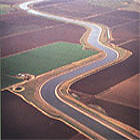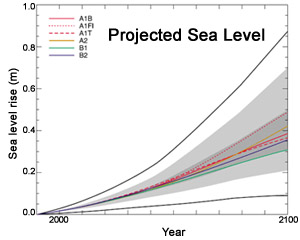The Future
 s climate changing? Evidence suggests that it is.
s climate changing? Evidence suggests that it is.

Summer sunset.
Photo courtesy NOAA.
- The concentration of greenhouse gases in the earth's atmosphere is now a third higher than the last interglacial period.
- The Earth's surface temperature has risen on average 0.6° C (1.08° F) over the last century.
- Glaciers are shrinking faster than at any time in the past 5,000 years.
- More than 80% of plants and animals under study are responding to warmer conditions by altering their spring behavior or range.
- All of these observations suggest that global warming is here now.
How may climate change affect California?

Water resources are vulnerable in semiarid regions.
With higher temperatures, more precipitation will fall as rain rather than snow and add to the severity of winter floods. Less Sierra snowpack means reduced water supplies in dry summer months. Snow will melt earlier, altering streamflow to the Sacramento Delta. In combination with sea level rise, earlier snow melt will lead to increased salinity in the Delta and affect water delivery to central and southern California.
California Aqueduct in central California. Photograph courtesy California Department of Water Resources.
• California's Water Plan Update 2004
• Preparing for Changing Climate
A Report of the California Regional
Assessment Group for the U.S. Global Change
Research Program
In a warmer world, weather patterns may be more extreme. Droughts may last longer. Storms and floods may increase in frequency and intensity. These climate changes are likely to stress beaches by increasing coastal erosion.
Over the next century, the potential impacts of climate warming will coincide with increased demands on water and coasts from a growing population.
Sea level rise may be the greatest long-term challenge for California's beaches.
Global average sea level is projected to rise 9 to 88 cm (4 to 35 in.) by 2100. The central value of 48 cm (1.6 ft.) gives a rate that is more than double the rate over the 20th century.

The IPCC (2001) sea level projections are based on 35 different CO2 emission scenarios and seven climate models. The region in dark shading is the range of the average of models for all 35 scenarios. The light shading is the range of all models for all 35 scenarios. The outer lines show the range of all models and scenarios including uncertainty in land-ice changes, permafrost changes and sediment deposition, but not instability of West Antarctic ice sheet. (Figure 11.12 in their report, p. 671).
Click here for IPCC (2001) sea level projections.
Click here for all IPCC Climate Change 2001 reports.
Click here for U.S. EPA sea level projections.
For the San Diego area, sea level increased about 20 cm (8 in.) in the last century. El Niño events can add another 30 cm (1 ft.) to sea level along the California coast.
Click here to see NOAA/NOS mean sea level trends for the last century.
Rapid sea level rise will affect our beaches, wetlands, and coastal structures.
Click on buttons to make a selection.
Rapid sea level rise will submerge the platform and the base of the sea cliff. Sand beaches will disappear unless much more sand is placed on the beach.
For each 50 cm (20 in.) rise in sea level along a cliffed coast, an additional volume of about 600 m3 (780 yd3) or more per meter (3.3 ft) of coast will be required to maintain the beach width we have today. This volume of sand is equivalent to 78 dump trucks for every meter length of beach. This is also about double the volume required to maintain the equilibrium winter beach at present sea level.
©2002-2003 by the Regents of the University of California and the Kavli Institute.
All rights reserved.
Last modifed Monday, August 25, 2003

